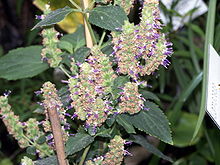Pogostemon
| Pogostemon | |
|---|---|

| |
| Pogostemon cablin | |
| Scientific classification | |
| Kingdom: | Plantae |
| Clade: | Tracheophytes |
| Clade: | Angiosperms |
| Clade: | Eudicots |
| Clade: | Asterids |
| Order: | Lamiales |
| Family: | Lamiaceae |
| Subfamily: | Lamioideae |
| Genus: | Pogostemon Desf. |
| Synonyms[1] | |
| |
Pogostemon is a large genus from the family Lamiaceae, first described as a genus in 1815. It is native to warmer parts of Asia, Africa, and Australia.[1]
The best known member of this genus is patchouli, Pogostemon cablin, widely cultivated in Asia for its scented foliage, used for perfume, incense, insect repellent, herbal tea, etc.[2] In 1997, it was proposed for the genus to be split into three subgenera— Allopogostemon Bhatti & Ingr., Dysophyllus (Blume) Bhatti & Ingr., and Pogostemon sensu Bhatti & Ingr. based on numerous morphological characteristics.[3][4][5] However, the significant variability in these traits as well as possible convergent evolution within this genus has made classification of species challenging.[3][6] Some members of the genus (e.g. Pogostemon erectus, Pogostemon stellatus, Pogostemon helferi) are grown ornamentally in the aquarium hobby and are used for aquascaping.
Selected species
Species include:[7]
- Pogostemon amaranthoides Benth.
- Pogostemon andersonii (Prain) Panigrahi
- Pogostemon aquaticus (C.H.Wright) Press
- Pogostemon atropurpureus Benth.
- Pogostemon auricularius (L.) Hassk. - southeast Asia
- Pogostemon barbatus Bhoti & Ingr.
- Pogostemon benghalensis (Burm.f.) Kuntze
- Pogostemon brachystachyus Benth.
- Pogostemon brevicorollus Y.Z.Sun
- Pogostemon cablin (Blanco) Benth. - South Asia & southeast Asia
- Pogostemon championii Prain
- Pogostemon chinensis C.Y.Wu & Y.C.Huang
- Pogostemon crassicaulis (Benth.) Press
- Pogostemon cristatus Hassk.
- Pogostemon cruciatus (Benth.) Kuntze
- Pogostemon dasianus A.B.De & Mukerjee
- Pogostemon deccanensis (Panigrahi) Press
- Pogostemon dielsianus Dunn
- Pogostemon elatispicatus Bhoti & Ingr.
- Pogostemon elsholtzioides Benth.
- Pogostemon erectus (Dalzell) Kuntze
- Pogostemon esquirolii (H.Lév.) C.Y.Wu & Y.C.Huang
- Pogostemon falcatus (C.Y.Wu) C.Y.Wu & H.W.Li
- Pogostemon formosanus Oliv. - Taiwan
- Pogostemon fraternus Miq.
- Pogostemon gardneri Hook.f.
- Pogostemon glaber Benth.
- Pogostemon glabratus Chermsir. ex Press
- Pogostemon globulosus Phuong ex Suddee & A.J.Paton
- Pogostemon griffithii Prain
- Pogostemon guamensis Lorence & W.L.Wagner - Guam
- Pogostemon hedgei V.S.Kumar & B.D.Sharma
- Pogostemon helferi (Hook.f.) Press
- Pogostemon heyneanus Benth. - South Asia & southeast Asia
- Pogostemon hirsutus Benth.
- Pogostemon hispidocalyx C.Y.Wu & Y.C.Huang
- Pogostemon hispidus (Benth.) Prain
- Pogostemon kachinensis (Mukerjee) Panigrahi
- Pogostemon koehneanus (Muschl.) Press
- Pogostemon linearis (Benth.) Kuntze
- Pogostemon litigiosus Doan ex Suddee & A.J.Paton
- Pogostemon lythroides (Diels) Press
- Pogostemon macgregorii W.W.Sm.
- Pogostemon manipurensis V.S.Kumar
- Pogostemon membranaceus Merr.
- Pogostemon menthoides Blume
- Pogostemon micangensis G.Taylor
- Pogostemon mollis Benth.
- Pogostemon mutamba (Hiern) G.Taylor
- Pogostemon myosuroides (Roth) Kuntze
- Pogostemon nelsonii Doan ex Suddee & A.J.Paton
- Pogostemon nepetoides Stapf
- Pogostemon nigrescens Dunn
- Pogostemon nilagiricus Gamble
- Pogostemon paludosus Benth. - southern India
- Pogostemon paniculatus (Willd.) Benth.
- Pogostemon parviflorus Benth.
- Pogostemon peethapushpum Pradeep
- Pogostemon peguanus (Prain) Press
- Pogostemon pentagonus (C.B.Clarke ex Hook.f.) Kuntze
- Pogostemon petiolaris Benth.
- Pogostemon philippinensis S.Moore
- Pogostemon plectrantoides Desf.
- Pogostemon pressii Panigrahi
- Pogostemon pubescens Benth.
- Pogostemon pumilus (Graham) Press
- Pogostemon purpurascens Dalzell
- Pogostemon quadrifolius (Benth.) F.Muell.
- Pogostemon raghavendranii R.Murugan & Livingst.
- Pogostemon rajendranii Ramasamy
- Pogostemon reflexus Benth.
- Pogostemon reticulatus Merr.
- Pogostemon rogersii N.E.Br.
- Pogostemon rotundatus Benth.
- Pogostemon rugosus (Hook.f.) El Gazzar & L.Watson
- Pogostemon rupestris Benth.
- Pogostemon salicifolius (Dalzell ex Hook.f.) El Gazzar & L.Watson
- Pogostemon sampsonii (Hance) Press
- Pogostemon septentrionalis C.Y.Wu & Y.C.Huang
- Pogostemon speciosus Benth.
- Pogostemon stellatus (Lour.) Kuntze - southeast Asia, southern China, northern Australia
- Pogostemon stocksii (Hook.f.) Press
- Pogostemon strigosus (Benth.) Benth.
- Pogostemon szemaoensis (C.Y.Wu & S.J.Hsuan) Press
- Pogostemon tisserantii (Pellegr.) Bhoti & Ingr.
- Pogostemon travancoricus Bedd.
- Pogostemon trinervis Chermsir. ex Press
- Pogostemon tuberculosus Benth.
- Pogostemon velatus Benth.
- Pogostemon vestitus Benth.
- Pogostemon villosus (Roxb.) Benth.
- Pogostemon wattii C.B.Clarke
- Pogostemon wightii Benth.
- Pogostemon williamsii Elmer
- Pogostemon xanthiifolius C.Y.Wu & Y.C.Huang
- Pogostemon yatabeanus (Makino) Press
References
- ^ a b Kew World Checklist of Selected Plant Families
- ^ Leung A, Foster S Encyclopedia of common natural ingredients used in food, drugs and cosmetics John Wiley and Sons 1996
- ^ a b Pramali, Kanjana; Bongcheewin, Bhanubong; Traiperm, Paweena (2018-06-01). "Leaf micromorphological adaptation of Pogostemon spp. (section Eusteralis) in Thailand". Agriculture and Natural Resources. 52 (3): 250–258. doi:10.1016/j.anres.2018.09.002. ISSN 2452-316X.
- ^ Bhatti, G. R. and M. Ingrouille. “Systematics of Pogostemon (Labiatae).” Bulletin of The Natural History Museum. Botany Series (1997): n. pag.
- ^ INGROUILLE, M. & Bhatti, Ghulamraza. (2008). Infrageneric relationships within Pogostemon Desf. (Labiatae). Botanical Journal of the Linnean Society. 128. 159 - 183. 10.1111/j.1095-8339.1998.tb02114.x.
- ^ Yao, G., Deng, Y., & Ge, X. (2015). A TAXONOMIC REVISION OF POGOSTEMON (LAMIACEAE) FROM CHINA. Phytotaxa, 200, 1-67.
- ^ The Plant List: A Working List of All Plant Species, retrieved June 19, 2016
